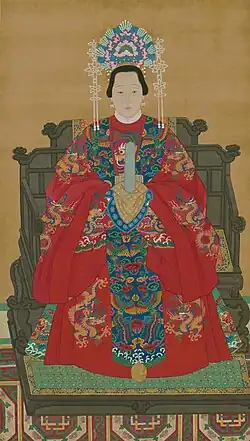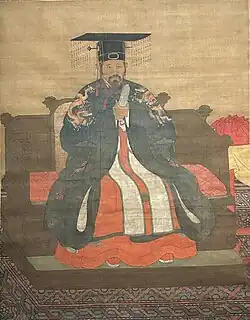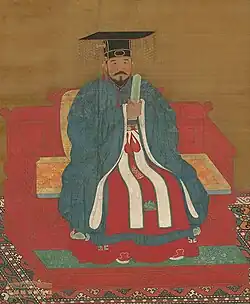Princess Caoguo
| Zhu Fonü 朱佛女 | |||||||
|---|---|---|---|---|---|---|---|
| Princess of the Cao State | |||||||
 | |||||||
| Born | 1317 Yangjiadun, Xuyi County, Si Prefecture (present-day Xuyi County, Huai'an, Jiangsu) | ||||||
| Died | 1350 (aged 32–33) | ||||||
| Spouse | Li Zhen | ||||||
| Issue | Li Wenzhong | ||||||
| Father | Zhu Shizhen | ||||||
| Mother | Lady Chen | ||||||
| Chinese name | |||||||
| Traditional Chinese | 曹國公主 | ||||||
| Simplified Chinese | 曹国公主 | ||||||
| |||||||
| Personal name | |||||||
| Chinese | 朱佛女 | ||||||
| |||||||
Princess Caoguo (or Princess of the Cao State; 1317–1350), personal name Zhu Fonü,[1] was the second elder sister of Zhu Yuanzhang, the founding emperor of the Ming dynasty. She was the mother of Li Wenzhong, Prince of Qiyang, one of the most celebrated founding generals of the dynasty.[2]
Although Zhu Fonü did not achieve great deeds or drive historical events, she was honored for her close association with historical figures Zhu Yuanzhang and Li Wenzhong.[1] After her death, Zhu Yuanzhang enfeoffed her as Princess Xiaoqin, emphasizing her filial piety.[3]
Life and family
Zhu Fonü was born in 1317 in Yangjiadun, Xuyi County, Si Prefecture (present-day Xuyi County, Huai'an, Jiangsu) as the second daughter of Zhu Shizhen and Lady Chen. After she reached her teens, she and her parents wandered before settling in Zhaoying, Taiping Township, Xuyi County, Si Prefecture (present-day Zhaofu Village, Mingguang Subdistrict, Mingguang, Anhui).[1] She married Li Zhen, a native of Lingji Village (then part of Xuyi County, now part of Mingguang, Anhui),[4] and gave birth to a son, Li Wenzhong.[2] Zhu Fonü died in 1350 and was temporarily buried in West Township, Zhongli County.[1]
In 1367, Li Wenzhong requested permission from his maternal uncle Zhu Yuanzhang to relocate his mother tomb. After receiving approval, Zhu Fonü's remains were subsequently reburied in the Lengshuijian plains of Lingji Township, Xuyi County (present-day entrance of Dali Village, Mingguang Subdistrict, Mingguang).[1]
In 1368, following the establishment of the Ming dynasty, Zhu Yuanzhang posthumously honored his elder sister as Princess Xiaoqin (孝親公主). Two years later, she was re-designated as Grand Princess Longxi (隴西長公主). In 1372, due to her son Li Wenzhong being granted the title Duke of Cao, she was further elevated to Grand Princess Caoguo (曹國長公主).[2]
During Zhu Yuanzhang's childhood, most of his relatives lived in poverty, but Li Zhen's family was relatively well-off and often assisted him. As a result, after Zhu Yuanzhang ascended the throne in 1368, he showed exceptional favor to Li Zhen's household above all other kin. Li Zhen was initially granted the titles of Marquis of Enqin and Commandant-escort. In 1370, he was further honored as Specially Promoted, Grand Master for Glorious Happiness, Commandant-escort, Left Pillar of State, and Duke of Cao. He died in 1378 and was posthumously enfeoffed as the Prince of Longxi, receiving the posthumous title "Gongxian". Zhu Yuanzhang also bestowed "princely titles upon three generations of Li Zhen's ancestors".[5]
Zhu Fonü's son, Li Wenzhong, was adopted by Zhu Yuanzhang and given the imperial surname Zhu.[6] He became a renowned general, strategist, and the third-ranking founding general of the Ming dynasty. After his death, he was posthumously honored as the Prince of Qiyang with the posthumous title "Wujing", and was enshrined in the Imperial Ancestral Temple.[7][8]
References
Citations
- ^ a b c d e Gong (2018), p. 296.
- ^ a b c History of Ming, vol. 121.
- ^ Xu, Yuyang (23 April 2023). 第五讲 艺术大讲堂——明代公主的生前身后事 [Lecture 5: Art Grand Lecture Hall – The Lives and Legacies of Ming Princesses] (in Chinese). Sanjiang University.
- ^ "Li Zhen jianli" 李贞简历 [Biography of Li Zhen] (in Chinese). Mingguang People's Government. 12 May 2017.
- ^ History of Ming, vols. 121, 126.
- ^ Taizu Shilu, vol. 1.
- ^ Guochao xianzheng lu, 5.
- ^ History of Ming, vol. 126.
Works cited
- Gong, Faqin (2018). Mingguang shihua 明光史话 (in Chinese). Anhui Literature and Art Publishing House. ISBN 9787539663111.
- Guochao xianzheng lu 國朝獻徵錄 [Evident (worthies) of Our Dynasty] (in Literary Chinese).
- Taizu Shilu 太祖實錄 [Veritable Records of Emperor Taizu] (in Literary Chinese).
- Zhang, Tingyu (1739). Ming Shi 明史 [History of Ming] (in Literary Chinese).

